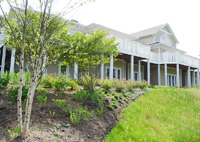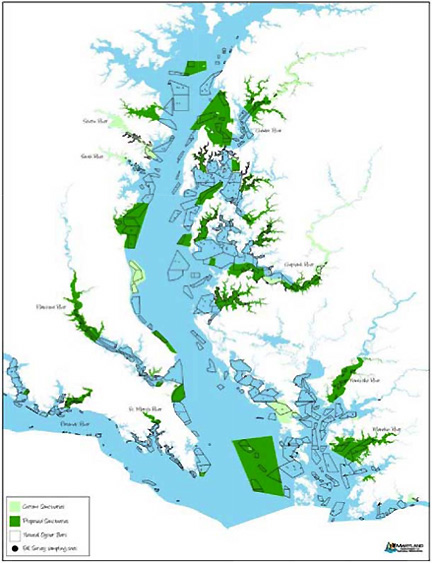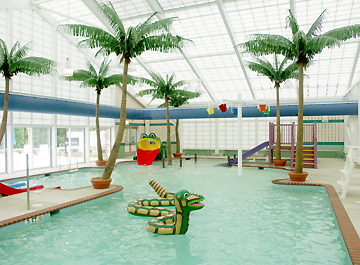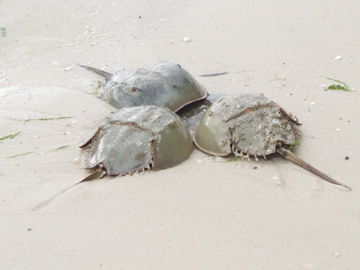Chesapeake Bay's Independent Newspaper ~ Since 1993
1629 Forest Drive, Annapolis, MD 21403 ~ 410-626-9888
Volume xviii, Issue 22 ~ June 3 to June 9, 2010
Home \\ Correspondence \\ from the Editor \\ Submit a Letter \\ Classifieds \\ Contact Us
Best of the Bay \\ Dining Guide \\ Home & Garden Guide \\ Archives \\ Distribution \\ Advertising![]()


Yeah a storm is threatening
my very life today
If I don’t get some shelter
Lord, I’m gonna fade away
You’ve heard that sanctuaries will be the salvation of Bay oysters.
If sanctuaries work like they’re supposed to, in their painstakingly cultivated, off-limits waters, oyster babies will live long, productive lives. They’ll multiply and be fruitful, reproducing their threatened species at the same time that they make homes for a zoo of other marine animals and vegetables. Busy little marvels, the voracious filter feeders also purify Bay waters as they eat.
What are these sanctuaries? Where are they? Will all these wonders happen in your watery back yard?
Read on for the answers, revealed in regulations detailed late last month by Gov. Martin O’Malley as part of Maryland’s Oyster Restoration and Aquaculture Development Plan. The regulations are not yet final; they’ll be published on July 1 for six weeks of public comment, with the hope that they’ll go into effect in early September, before wild-harvest oyster season opens October 1.
“Today we are on the verge of making history, as we stand on the threshold of implementing a plan that was called for by the very first oyster advisory commission in the 1800s, but was never achieved,” said O’Malley.
Sanctuaries are part of the history-making step. Under the plan, they’ll cover 25 percent of the 36,000 acres of existing quality habitat in the Bay and its tributaries. That’s a 16 percent increase.
“Quality habitat,” according to Mike Naylor, Maryland Department of Natural Resources’ man on shellfish, means “Oysters are there now: that’s why the areas are productive.”
Most productive, according to an independent analysis commissioned by DNR of all 282 oyster bars in the state’s fall survey, are those in the mid-salinities, 12 parts salt per thousand.
“The epicenter,” Naylor says, “is in the vicinity of St. Michaels, Eastern Bay, and the Choptank and Little Choptank rivers.
Accordingly, a lot of new sanctuaries are concentrated in that area.
But sanctuaries extend throughout the whole range of Bay waters, tributaries and salinities to reach the goal of restoring oysters throughout the Bay.
On the Western Shore, much of the Magothy, Severn and South rivers will be sanctuaries. Farther south, so will the mid stretch of the Patuxent, Breton Bay and the upper reaches of the St. Mary’s River, which was Maryland’s most productive habitat for spat last year. Along the Western Shore, all of Herring Bay will be a sanctuary, along with the Calvert shoreline north of Cove Point and St. Mary’s shoreline at Point Lookout.
The southernmost sanctuaries are on the Eastern Shore, near Tangier Sound in the main Bay in the Nanticoke and Manokin rivers.
Retired Herring Bay crabber Scott Smith is delighted that a sanctuary will be his new neighbor. “I think the top priority of the oyster recovery program should be to promote the health of the ecosystem,” Smith says.
On the other hand, he adds, “I like to eat oysters and would not object to creating a sustainable, profitable harvesting industry once we achieve that goal.”
Department of Natural Resources will continue to plant shell and seed not only in the sanctuaries but also in the other 75 percent of remaining quality oyster habitat.
However, watermen, who’ve always been the conduit between Bay oysters and the nation’s oyster eaters, fear the placement of sanctuaries gives them the short end of the stick.
“The watermen are not opposed to the expansion of the sanctuaries,” says Smith’s Fairhaven neighbor Mick Blackistone, editor of the Waterman’s Gazette. “What they are opposed to is the government taking the best bottom. There have to be compromises with the Watermen’s Association and the watermen that need to oyster.”
That’s what the months ahead are for. We’ll keep you informed.
–Sandra Olivetti Martin with Ron Stein
Dive into Calvert’s New Aquatic Center
 Dive, jump, wade or tiptoe: four pools give you many choices
Dive, jump, wade or tiptoe: four pools give you many choices
Cool off in not just one but any of three indoor pools at Calvert’s sparkling new Edward T. Hall Aquatic Center. Warm up in a fourth.
The 41,000-square-foot complex just above Prince Frederick gives water-lovers of all ages and temperature inclinations their choice of pools. The 50-meter competition pool, at 82 degrees, includes shallow-water and deep-water play areas, a lap section and a diving pool served by half-, one- and three-meter boards.
The therapy pool, at 88 degrees, is a safe retreat for seniors and a warm-up for kids under five. The family-friendly leisure pool features three slides, a gusher entrance and buckets of water tipping from above, as well as a sea serpent. The fourth pool is a hot tub for adults 18 years and older. There is more to the center than getting wet: a fitness room with cardiac and weight machines, a meeting room and a party room.
An indoor pool — to extend the season of the two outdoor pools, Kings Landing and the newer Cove Point Park — has been on Calvert’s wish list for more than two decades.
Commissioner Susan Shaw says she started working on the project before being elected seven and a half years ago.
“I felt I had to get elected to make it happen,” she tells Bay Weekly. “It took years to get a consensus.”
In the early years of dreaming, the county worked with the YMCA, hoping the National Capital arm of the well-known organization would build — and pay for — the year-round pool. Locations were put on, then taken off the table for both financial and political reasons.
In the end, the county decided to build independently, on a newly opened spot on Auto Drive, behind Bayside Toyota and connecting to Prince Frederick Boulevard.
The funding for the facility and land — almost $20 million — came from a combination of Maryland’s Project Open Space money, County Parks and Recreation excise taxes and bond funding.
“Our goal is for the center to be self-supporting,” Shaw says. “Like Breezy Point Beach and Campground.”
The center is open to everyone — Calvert resident or not.
“Because we used Project Open Space money,” explains Shaw, “it can’t be restricted to just residents of our county.”
Future plans call for a community center behind the aquatic center —which explains the extra-large parking lot.
“It was designed to accommodate both facilities at some point in the future,” Shaw says.
The center will bring a mini-employment boom to Calvert. Sixty-five full- and part-time seasonal jobs will need to be filled to keep the facility afloat.
Dive in for free from 3-10pm on Tuesday June 8 when the aquatic center officially opens. The next day regular hours and fees kick in: $6 w/age discounts and annual and seasonal passes. Open weekdays 6am-10pm; weekends 8am-10pm: 410-414-8350; www.co.cal.md.us/residents/parks/events/hac
–Margaret Tearman
This Week’s Creature Feature
Horseshoe crabs love a full moon
![]() Horseshoe crabs, one of the Bay’s links to prehistory, hear the call of summer’s new and full moon and crawl out of the water to mate. They arrive at high tide, when the greenish clumps of eggs deposited by the female are farthest from the churning waves.
Horseshoe crabs, one of the Bay’s links to prehistory, hear the call of summer’s new and full moon and crawl out of the water to mate. They arrive at high tide, when the greenish clumps of eggs deposited by the female are farthest from the churning waves.
This is not a sight for the puritanical; the ancient creatures are polygamous, with as many males as possible clinging to a larger, fertile female. The male fertilizes the eggs as they are dug into the sand. Her golf-ball sized clutches contain thousands of eggs; still, she repeatedly returns to lay more, depositing some 90,000 eggs in a season.
Only a fraction of the horseshoe crab eggs will develop to maturity. But that fraction has been large enough to sustain the species for some 350 million years.
You can have a night of crab voyeurism at any sheltered stretch of beach on the Bay or one of its broad rivers. Your next chance will be the new-moon cycle on the weekend of June 12. Bay Weekly prints daily tide times.
If you return after the orgy, gently right any upturned horseshoe so it can return to the life-giving water to hear the next call of the moon.
–Sandra Olivetti Martin
The Blues Earn Plenty of Green
In the aftermath of a two-day blues festival, Don Hooker pulled in lots of cash and picked up thousands of cigarette butts
The Blues Festival ended as the sun went down May 23, but festival organizer Don Hooker’s been a busy man.
“I spent the last week cleaning up,” he says. “It’s the inglorious part of being a promoter.”
The glorious part is earning money for the four charities he selected this year.
“We know we raised at least $40,000,” says Hooker. “But not all the bills are in yet. I suspect it’s more than that.” He estimates that the taking this year, in spite of a drizzly Saturday, makes this the third or fourth most successful blues fest.
The festival also played host to many memorable performances, from Buddy Guy’s wet tour-de-force to Church Berry’s red sequenced boogie-woogie.
As for Hooker, his favorite moment was Buddy Guy: “Watching Buddy Guy walking through the crowds playing in the rain. Usually it’s all of us getting wet while we watch him play.”
The show must go on, even if the stage has been broken down and the audience has left. Hooker must spend a week cleaning the park so that summer revelers can take over.
“I finished my last chore on Thursday last week,” reports Hooker, “which was power washing the parking lot where the dumpster sat.”
He has his audience to thank for the relatively quick clean up.
“The audience picks up their trash as they leave,” Hooker says. “We get there Monday morning, and we can’t believe how clean the park already is.”
Still, Hooker wishes smokers were as fastidious. “Honestly, the worst part is picking up cigarette butts,” he says. “Probably [I picked up] over a thousand. It goes with the turf.”
–Diana Beechener
Calvert Hospice sees green from 2008’s Maryland Home and Garden Pilgrimage
Two years ago, Margaret Tearman told you how the owners of three Calvert County homes scrubbed, weeded and polished to get ready for the 2008 Maryland Home and Garden Pilgrimage (www.bayweekly.com/year08/
issuexvi18/leadxvi18_1.html).
All their hard work is history, but its consequences are bursting into bloom in the new garden of Burnett Calvert Hospice House.
Burnett Calvert Hospice House is located on Barbara and Robert Burnett’s former Calvert Homestead. On their historic Calvert County farm, the Burnetts raised flowers and a successful business from fashioning their crops as home decorations. After Robert’s death from an Agent Orange-related cancer in 2000, Barbara donated two and a half acres and the historic house to become Burnett Calvert Hospice House.
Now the Hospice House once again has a garden, paid for with a donation from the Calvert Garden Club of over $14,000 raised at Calvert’s 2008 leg of the annual statewide pilgrimage, which was sponsored by the Garden Club.
“We put a lot of thought into picking garden items that would provide scents and sights offering peace, comfort and a calmness to Hospice House patients and their visitors,” said Mary Oritt, chair of the Calvert Garden Club project.
The 1,000 square foot sensory garden was landscaped by McHale & McHale Landscape Design.
–Sandra Olivetti Martin
Memorial Weekend is over, and the hundreds of boats that passed by did not deter our little mother from her appointed task. A boat crowded with people tied up at my neighbor’s pier not 30 feet from the nest, but our girl stayed put. Oliver was upset and flew around in circles for a while, but, eventually, even he accepted the boat’s presence.
Not much else to report on our twosome, except that they continue to persevere in their efforts to bring new life into the world.
Thus continues Michael Koblos’ 26-week saga of the doings of his nearest osprey family. A 78-year-old retired naval officer, Koblos lives in a small cottage on the water, Home Port, in a place called Cobb Island, located in the wide Potomac River about 50 miles south of Washington, D.C.
© COPYRIGHT 2010 by New Bay Enterprises, Inc. All rights reserved.



